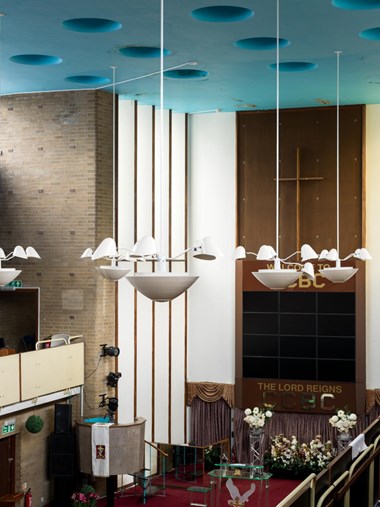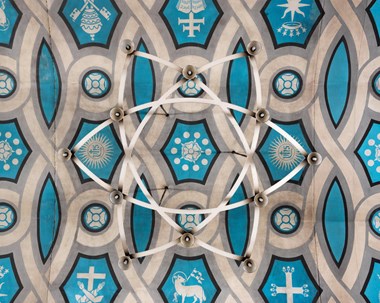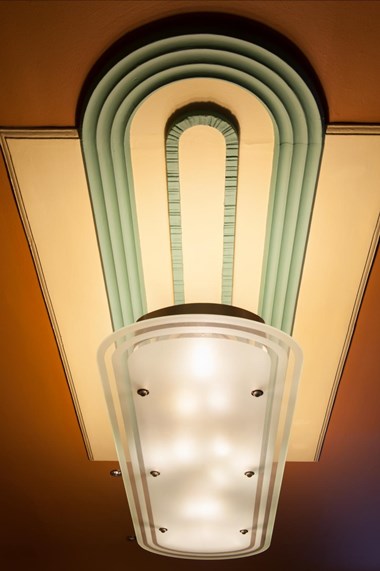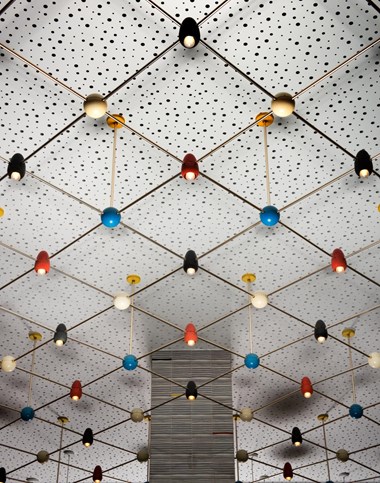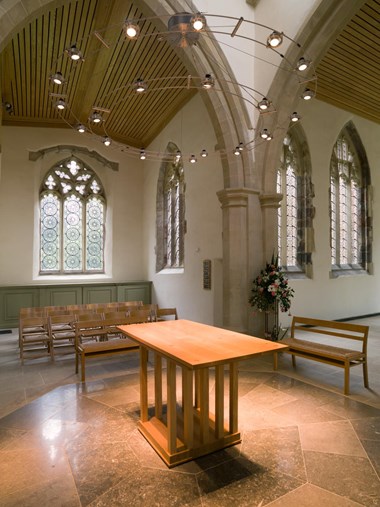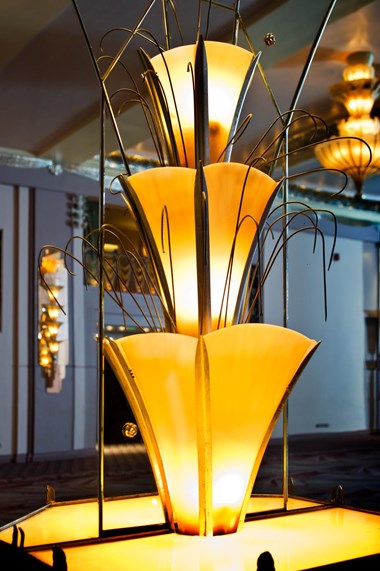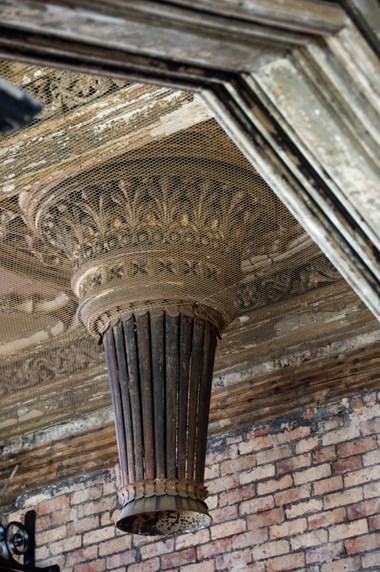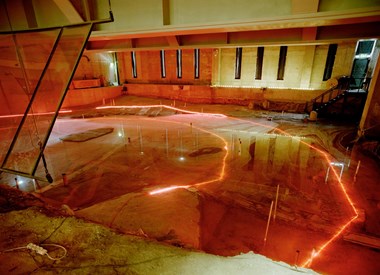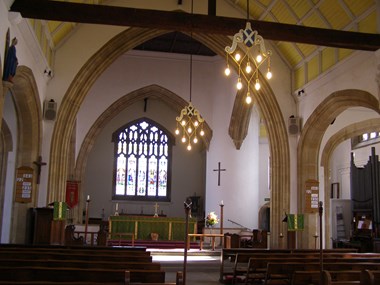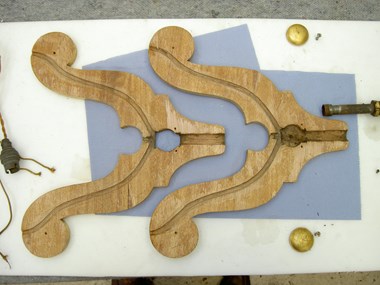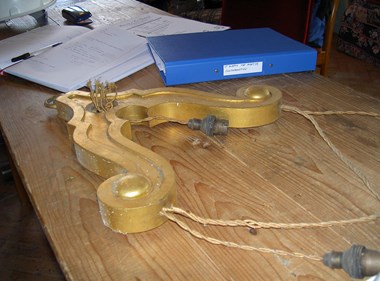Internal Lighting in Historic Buildings
This section covers the issues to be considered when refurbishing historic internal lighting or designing and installing a new layout. Read on to find advice on light fittings, types of lamps and their suitability, installation, control systems and maintenance.
The design of new lighting needs to take into account the building's internal layout and any historic interior decoration.
Any examples of early gas or electrical light fittings that have survived should, wherever possible, be left in position and form a part of the new lighting scheme, if feasible.
Historic electric light fittings
Electric lighting is a relatively new component to most heritage interiors. Unless the building dates from after 1920 it's most likely that it would have originally been lit with wax candles, oil lamps or gas mantle lighting.
There are some rare exceptions to this trend. Public buildings and large houses tended to have electricity installed earlier, often locally generated by the property’s own DC (direct current) generators as was the case in the John Rylands Library, Manchester (opened 1900) or by hydroelectricity such as found at the National Trust property Cragside in Northumberland (installed in 1878 and used in 1880 to light Swan’s incandescent lamps). The original lighting installations at these two sites are still functioning.
Electric lighting took a while to become accepted and affordable. For most people early light fittings were often adapted from gas fitments with the associated gas pipework used to carry the wiring.
The novelty of electric light, coupled with the poor light output from early lamps, meant that the fittings were often designed not to have shades.
Where good examples of early electrical light fittings exist, and it is possible to leave them in position as part of the new lighting, then this is the preferred arrangement.
Design considerations
There are a number of design issues that you should consider when planning a new or replacement internal lighting scheme for a historic building. When preparing a design you'll need to think about:
- What's the design of the room / building?
- What activities are going to take place there?
- Are there any existing light fittings of historic interest?
- Can these historic light fittings be salvaged, reconditioned and reused in the new scheme, and if not what's going to happen to them?
- Is the building listed?
- Is the interior highly decorated or finished with decorative, delicate, light-sensitive fabrics such as silk wallpaper?
- Are there pictures to be illuminated?
- Is dimming required?
- Will integral emergency lighting be needed?
- Will 6amp lighting sockets be required?
- Are daylight controls and occupancy sensors being incorporated?
- Is remote control required?
- Can wireless switching be used to avoid permanent damage to the historic fabric?
Remember that lighting design combines artistry, science and engineering so a purely technical application is not the right approach. A good lighting scheme is more than light levels and glare factors.
The main objectives of a good internal lighting scheme are:
- To provide appropriate levels of light to carry out the tasks likely to be performed in the space
- To ensure that the lighting has good levels of control so that different scenarios can be lit in the most effective and energy efficient way
- That any auxiliary lighting, such as picture lighting and table lamps can be accommodated and controlled easily, and if necessary, separately
- That the installation is easy to maintain, clean and re-lamp
- That the installation is the most energy efficient it can possibly be
Designing lighting for the visually impaired
Historic England is committed to improving the accessibility to the historic environment for people with disabilities.
More than 2 million people in the UK have a visual impairment that impacts their lives. People with ADHD, Autism, Dyspraxia, and Dyslexia all fall within this range. Age-related macular degeneration affects almost half a million people (23% of those with visual impairment).
Good lighting allows people to move easily and safely into and around historic buildings. Effectively used, it can make obstacles appear more obvious and guide people along routes.
The Pocklington Trust’s ‘Lighting in and around the home. A guide to better lighting for blind and partially sighted people’ (updated 2021) explains the principles and practicalities of good lighting.
In addition to the design considerations listed in the above section, you need to think about:
- Avoiding glare, pools of bright light or areas of deep shadow. For example, window blinds can help eliminate glare or confusing shadows
- Transitions from brightly to dimly lit spaces and avoiding sudden changes in light levels. Integrating pause or rest spaces can help people adjust to the changes in lighting levels
- Making the most of natural daylight
- Supplementing lighting with sensitively positioned additional fittings particularly in areas such as staircases and corridors
- Installing easy-to-use and adjustable lighting level controls for all lights
- Using lights that do not flicker or create strobe effects
- Simple and low-cost changes such as adding task lights, decorations, colours and furniture layout that can help too
Internal lighting image gallery
Please click on the gallery images to enlarge.
Reusing historic light fittings
When historic light fittings are retained and reused in a new lighting scheme it is important to remember that they are unlikely to have been manufactured or installed when it was mandatory to have a circuit protective conductor (CPC) or earth on a lighting circuit. Lighting circuits installed before 1966 often did not have a circuit protective conductor.
Although it is not mandatory to rewire an existing lighting circuit any new work must be carried out in accordance with the current edition of BS 7671 Requirements for Electrical Installations and without impairing the safety of the existing installation.
If a metal light fitting or switch plate is installed (Class I equipment) then the installation of a protective conductor is essential. Without a CPC there is a risk of electric shock under fault conditions and fittings will fail the periodic PAT test.
Where an existing lighting circuit without a CPC is to be extended or altered work should not be carried out unless the rating and condition of the existing equipment can be upgraded to meet the requirements of BS 7671. When upgrading it is important to look at the size (cross-sectional area) of the existing conductors and type and rating of the protective devices.
It is therefore strongly recommended that a CPC should be connected to any existing metallic Class I equipment connected to the lighting circuit. If this equipment is not already satisfactorily earthed, or has no capability of being earthed as would be the case in heritage light fittings and accessories, then it is strongly recommended that the heritage lighting fittings and switch plates are completely refurbished by an appropriate specialist with reinforced insulated components. (The reinforced insulation, just like the double insulation ensures that even if one of insulation layer fails, the remaining layer will continue providing insulation, hence making the device or equipment safe). The installation also needs to be rewired with a suitably sized CPC or the fittings are connected to the nearest earth connection point of the installation.
Light refurbishment image gallery
1930s light fittings designed by the architect Nugent Francis Cachemaille-Day were assessed and refurbished for reuse at St Alban the Martyr Church in Swayling. Click on the images to enlarge.
Learn more: Historic England webinars
- View the recording of the 2020 webinar: Internal lighting for historic buildings
This webinar gives a brief overview of the new Historic England internal lighting guidance. It includes advice on how best to approach an internal lighting project within a historic interior. It covers the issues and equipment to consider before starting a project. - View the 2021 webinar on Climate change adaptation: Saving energy through daylight harvesting
Daylight harvesting uses daylight to offset the amount of electric lighting needed to light a space, thereby reducing the energy consumed. Daylight harvesting also uses lighting control systems that are able to dim or switch electric lighting in response to changing daylight availability.
For the best webinar experience, please use Google Chrome browser or download Adobe Connect.


